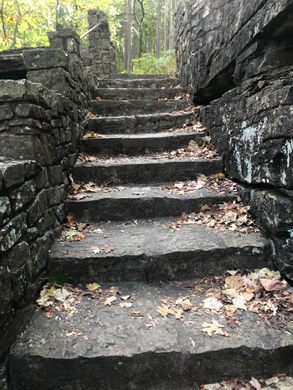Heavener Runestone
One believer transformed a local curiosity into proof of Vikings on the Great Plains.
One woman’s relentless belief turned what was just an odd stone into the central monument of a state park. The Heavener Runestone is a ten-foot by twelve-foot high sandstone slab carved with symbols that are controversially attributed to the Vikings. For nearly a century, locals referred to it as the “Indian Rock” and assumed that the inscription was made by the Choctaw.
The Indian Rock was a little known curiosity until Gloria Farley of Heavener turned her childhood fascination into a lifelong investigation. She first visited the site in 1928 as a young girl, returning in 1951, determined to solve its mysteries. Her research, and that of the scholars she helped bring to Heavener, was aimed at proving Vikings had inscribed the sandstone in the 11th century. The Smithsonian Institution identified the eight carved characters as Scandinavian, interpreting them as “GNOMEDAL,” or “gnome” and “dal,” meaning sundial, or possibly monument valley. In 1986, Dr. Richard Nielson from the University of Denmark translated them as “GLOMEDAL,” meaning “Glome’s Valley.” (In the Scandinavian country of Denmark, there is no University of that name, so unless we are talking about an American University in a place called Denmark, this information is incorrect.)
Not everyone, however, is convinced Norsemen sailed up the Arkansas River to the Great Plains nearly 500 years before Columbus came to America. Others speculate that the runestone was carved by someone on the French explorer La Salle’s expedition in the 17th century, or by a Swedish captain during a period of 18th-century French colonization. Still others believe the rock may be a hoax created by a 19th-century Scandinavian farmer. Skeptics point out that there are no other remaining artifacts of Vikings in Oklahoma, although similar runestones have been found in Poteau, Shawnee, and Tulsa.
Authentic or not, the runestone and the area around it were incorporated into a 50-acre state park in 1970. Gloria Farley’s dedication to preserving the runestone subsequently protected the beautiful cliffs of Poteau Mountain and the forest around it, and the park is now known as much for its hiking and sunsets as for its supposed Viking past.
Know Before You Go
Heavener State Park is on top of Poteau Mountain, one and a half miles northeast of Heavener, off of State Highway 59 and US Highway 270.
Admission is free and there's also a tent camping sites available to book.
The Atlas Obscura Podcast is Back!





































Follow us on Twitter to get the latest on the world's hidden wonders.
Like us on Facebook to get the latest on the world's hidden wonders.
Follow us on Twitter Like us on Facebook